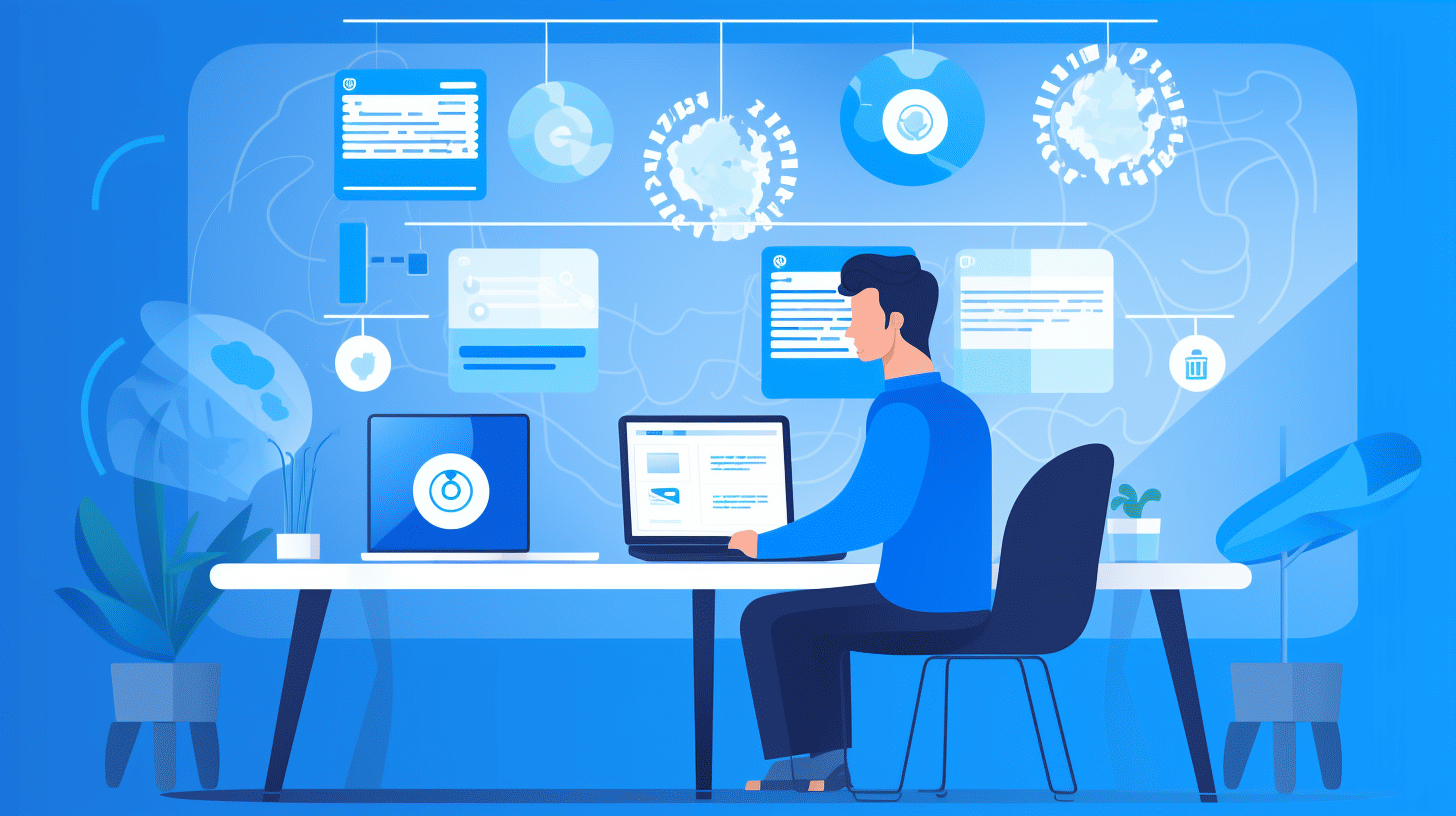Managing multiple WordPress websites can be a daunting task. From keeping up with updates and security measures to ensuring efficient workflows and minimizing downtime, there are many challenges to navigate. However, with the right strategies and best practices in place, managing multiple WordPress sites can become a streamlined and efficient process.
In this article, we will explore the best practices for managing multiple WordPress websites to ensure both safety and efficiency. From standardizing plugins and themes to utilizing WordPress management tools and consolidating hosting, we will cover a range of strategies to help you effectively manage your websites.
Whether you are a web designer, developer, or a business owner with multiple WordPress sites, these best practices will help you stay organized, secure, and efficient in your website management tasks. So let’s dive in and discover how to effectively manage multiple WordPress websites!
Best Practices for Managing Multiple WordPress Websites
Managing multiple WordPress websites can be a daunting task, but with the right strategies in place, you can streamline your workflow and ensure consistency across all your sites. In this article, we will explore some best practices to help you effectively manage multiple WordPress websites.
Standardize Plugins and Themes
One of the key challenges in managing multiple WordPress websites is maintaining consistency across all the sites. It can be time-consuming and error-prone to manually update plugins and themes on each site individually. To overcome this challenge, it’s essential to standardize the plugins and themes used across all your websites.
By standardizing plugins and themes, you can:
- Ensure consistent functionality and design across all your sites.
- Simplify the maintenance process by updating plugins and themes in one place.
- Reduce the risk of compatibility issues between different versions of plugins and themes.
For example, you can create a list of approved plugins and themes that meet your requirements and install them on all your websites. This way, you can easily manage updates and ensure that all sites are using the latest versions.
Use WordPress Management Tools
To efficiently manage multiple WordPress websites, utilizing WordPress management tools can be a game-changer. These tools provide a centralized platform to monitor and control all your sites from one dashboard. Here are some popular WordPress management tools:
- MainWP: Offers a user-friendly interface to manage multiple sites.
- InfiniteWP: Allows you to update plugins, themes, and WordPress core across all your sites with a single click.
- CMS Commander: Provides a comprehensive suite of tools for managing multiple WordPress sites, including backup, security, and content management.
- ManageWP: Lets you manage and update multiple WordPress sites from one place, along with additional features like website uptime monitoring and performance optimization.
- WPRemote: Offers a straightforward interface for managing updates, backups, and security settings for multiple WordPress sites.
These tools can automate several tasks, saving you time and effort while ensuring that your websites are up to date.
Streamline Workflow with Consolidated Hosting
Managing multiple WordPress websites becomes more efficient when hosting is consolidated. Consolidating hosting means hosting all your websites on a single platform or server. This approach has several benefits:
- Simplifies the management process and reduces the need to switch between different hosting providers.
- Provides better control and easier access to all your websites.
- Reduces costs by leveraging bulk pricing and shared resources.
Consolidating hosting can be achieved by:
- Choosing a web host that offers scalable and flexible hosting plans to accommodate multiple websites.
- Migrating all your websites to a single hosting provider and optimizing the server environment for WordPress.
By consolidating hosting, you can streamline your workflow and focus more on managing and optimizing your websites rather than dealing with multiple hosting platforms.
In conclusion, managing multiple WordPress websites requires careful planning and the right tools. By standardizing plugins and themes, using WordPress management tools, and consolidating hosting, you can efficiently manage all your sites while ensuring consistency and streamlining your workflow.
For more insights on streamlining your WordPress development workflow, you can visit this link.
Security Measures for WordPress Websites
WordPress is one of the most popular content management systems in the world, powering millions of websites. However, its popularity also makes it a target for malicious actors looking to exploit vulnerabilities and gain unauthorized access. As a website owner, it’s crucial to implement robust security measures to protect your WordPress site and its valuable data.
In this article, we will explore some essential security measures that can help safeguard your WordPress website from threats. By following these precautions, you can enhance the security of your site and ensure the safety of your visitors’ information.
Password Management and Authentication
One of the fundamental security measures for any website, including WordPress, is effective password management. Here are a few tips to improve password security:
- Use strong, unique passwords: Avoid using common or easily guessable passwords. A combination of uppercase and lowercase letters, numbers, and symbols makes for a strong password.
- Limit login attempts: Implementing a limit on login attempts can protect against brute force attacks, where hackers try multiple login combinations to gain access. After a certain number of failed attempts, the user should be temporarily locked out.
🔐 Pro Tip: To manage and enforce strong password policies, consider using a password management tool or plugin like Effective WordPress Website Management. It can help you generate strong passwords, store them securely, and streamline the login process for your users.
Implementation of SSL Certificates
Securing the communication between your website and its users is crucial. By implementing SSL (Secure Sockets Layer) certificates, you can ensure that the data transmitted between your site and visitors is encrypted and protected. Here’s why SSL certificates are essential:
- Data encryption: SSL certificates encrypt sensitive information, such as login credentials and personal data, preventing unauthorized access.
- Trust and credibility: SSL certificates show your visitors that you prioritize their security, boosting their confidence in your website.
- SEO benefits: Search engines like Google prioritize websites with SSL certificates, which can lead to higher rankings in search results.
🔒 Fun Fact: Did you know that websites with SSL certificates display a padlock icon in the address bar, indicating a secure connection? Users are more likely to trust and engage with websites that have this visual confirmation of security.
Using WordPress Security Plugins
WordPress security plugins are powerful tools that can help protect your website from various threats and vulnerabilities. These plugins offer features such as malware scanning, firewall protection, and login lockdowns. Here are a few popular WordPress security plugins to consider:
- Wordfence Security: A comprehensive security plugin that includes a firewall, malware scanner, and login protection.
- Sucuri Security: Offers website monitoring, malware scanning, and DDoS protection, among other features.
- iThemes Security: Provides brute force protection, file change detection, and database backups.
🛡️ Pro Tip: Remember to regularly update your security plugins to ensure you have the latest protection against emerging threats.
Regular Updates to Themes, Plugins, and WordPress Core Files
Keeping your WordPress installation up to date is essential for maintaining a secure website. WordPress releases regular updates that include bug fixes, security patches, and performance enhancements. Likewise, updating themes and plugins is equally crucial. Failure to update can leave your site vulnerable to hackers looking to exploit known vulnerabilities.
🔄 Fun Fact: Did you know that 74% of WordPress attacks are a result of outdated versions of plugins and themes? By staying vigilant and promptly updating, you can significantly reduce the risk of a security breach.
Implementing a robust security strategy is vital to protect your WordPress website and the valuable data it holds. By following these security measures, including strong password management, SSL certificates, security plugins, and regular updates, you can significantly mitigate the risk of malicious attacks and ensure the safety of your website and its visitors.
Remember, effective WordPress website management is not just about creating great content and design; it also involves prioritizing security to provide a safe experience for your users.
Secure your WordPress website today and ensure your peace of mind!
Disaster Recovery and Minimizing Downtime
Imagine this scenario: You’ve been working hard on your WordPress website for months, pouring your heart and soul into creating engaging content, perfecting the design, and attracting a loyal following. It’s your digital baby, and you want to protect it from any harm that may come its way. Unfortunately, disasters can strike at any moment, whether it’s a hardware failure, a cyberattack, or even a simple human error. That’s where disaster recovery and minimizing downtime come into play.
When it comes to disaster recovery and minimizing downtime for your WordPress site, one crucial step you must take is regularly backing up your website. Regular backups provide you with a safety net, enabling you to restore your site to a previous working state in case something goes wrong. And let’s face it – something will inevitably go wrong at some point.
When you back up your WordPress site regularly, you ensure that you have a clean, up-to-date copy of your website’s files and database. This backup serves as your fallback plan, your insurance policy, ensuring that your hard work and valuable data are protected. So, how can you go about backing up your WordPress site in an efficient and hassle-free manner?
Here are a few tips to help you get started:
- Automate the Process: Manual backups are time-consuming and prone to human error. Opt for a reliable WordPress management service like Managed-WP, which offers automated backups as part of its features. It takes the hassle out of the process and ensures that your site is backed up regularly without you having to lift a finger.
- Select the Right Backup Frequency: The frequency of your backups will depend on how frequently you update your website. If you make changes daily, it’s wise to opt for a daily backup schedule. However, if you update your site less frequently, a weekly or monthly backup may suffice. Assess the needs of your site and choose a backup frequency that aligns with your update schedule.
- Store Backups Securely: Your backups are only as good as their storage location. It’s crucial to choose a secure and reliable backup storage solution. Consider using off-site storage options such as cloud storage or external hard drives. This ensures that even if your website’s servers are compromised, you’ll still have access to your backups.
Remember, disaster recovery and minimizing downtime go hand in hand. By regularly backing up your WordPress site, you’re setting yourself up for quick and efficient recovery in case of any unforeseen events. Take the necessary steps now to safeguard your website and protect your hard work. Don’t wait until it’s too late!
So, whether you’re a seasoned website owner or just starting out, don’t underestimate the importance of regular backups for disaster recovery and minimizing downtime. Make it a priority for your WordPress site today, and rest easy knowing that you’re prepared for any bumps in the road that may come your way.
To learn more about the features offered by Managed-WP and how it can help with disaster recovery and minimizing downtime, check out their Managed-WP Features page.
Access and Management of Multiple WordPress Sites
Are you tired of juggling multiple logins and dashboards just to manage your WordPress sites? Well, you’re in luck! There are powerful tools available that will make your life easier by allowing you to access and manage multiple WordPress sites from a centralized platform. Say goodbye to the headache of switching between different sites and streamline your workflow with these handy tools.
Utilisation of Multisite Management Tools
One of the most popular and reliable tools for managing multiple WordPress sites is ManageWP. This powerful multisite management tool allows you to handle all your WordPress sites from one convenient dashboard. With ManageWP, you can:
- Efficiently Manage Multiple Sites: Instead of logging in to each site individually, ManageWP allows you to access all your sites from a single interface. You can perform updates, backups, and other management tasks for multiple sites simultaneously.
- Monitor Site Performance: With ManageWP, you can easily keep an eye on the performance of all your WordPress sites. Get real-time data on website uptime, load time, and other crucial metrics to ensure your sites are running smoothly.
- Automate Routine Tasks: Save time by automating routine tasks with ManageWP. Schedule backups, updates, and security scans, so you can focus on more important aspects of your business.
- Enhance Security: Maintain the security of your WordPress sites with ManageWP’s built-in security features. You can run security scans, monitor for vulnerabilities, and even implement two-factor authentication for added protection.
ManageWP is not the only option available for managing multiple WordPress sites. Another popular tool is InfiniteWP. It offers similar features and functionality, allowing you to manage an unlimited number of WordPress sites from a single dashboard.
Take control of your WordPress sites and simplify your workflow with these powerful multisite management tools. With their user-friendly interfaces and robust features, you’ll wonder how you ever managed without them. So, why wait? Try out ManageWP or InfiniteWP and experience the convenience of centralized WordPress site management today!
Conclusion
In conclusion, managing multiple WordPress websites requires careful attention to best practices for safety and efficiency. By standardizing plugins and themes, using WordPress management tools, and streamlining workflows with consolidated hosting, website owners can ensure smooth operations and consistent performance across their sites.
Security measures such as password management and authentication, implementation of SSL certificates, and the use of WordPress security plugins are vital in safeguarding websites against potential threats. Regular updates to themes, plugins, and WordPress core files are also crucial to optimize security and keep websites protected.
When it comes to disaster recovery and minimizing downtime, regular backups of WordPress sites are essential. These backups serve as a safety net, allowing website owners to quickly restore their sites in the event of any data loss or website malfunctions.
For efficient access and management of multiple WordPress sites, the utilization of multisite management tools can greatly simplify the process. These tools provide a centralized dashboard for managing all sites, allowing website owners to save time and effort in handling various tasks.
In summary, following these best practices for managing multiple WordPress websites can help ensure the safety, efficiency, and smooth operation of your online presence. Consider leveraging Managed-WP, a premium managed WordPress cloud hosting platform that simplifies infrastructure and offers expert 24/7/365 problem-solving. With Managed-WP, you can focus on driving digital experiences while leaving the technical aspects in capable hands. Learn more about Managed-WP here.
Frequently Asked Questions
- What are the best practices for managing multiple WordPress websites?
Some best practices for managing multiple WordPress websites include using a centralized management tool, keeping themes and plugins up to date, using strong and unique passwords, regularly backing up your websites, and implementing a reliable security plugin.
- Should I use a centralized management tool for multiple WordPress websites?
Yes, using a centralized management tool like ManageWP, InfiniteWP, or MainWP can greatly simplify the process of managing multiple WordPress websites. These tools allow you to update plugins, themes, and WordPress core from a single dashboard and provide other useful functionalities.
- How important is it to keep themes and plugins updated?
Keeping themes and plugins updated is crucial for the security and performance of your WordPress websites. Outdated themes and plugins can have vulnerabilities that hackers can exploit. Regular updates ensure that you have the latest features, bug fixes, and security patches.
- Why is it important to use strong and unique passwords for each website?
Using strong and unique passwords for each website is important to prevent unauthorized access. If one website gets compromised, having unique passwords for each site ensures that the other websites remain secure. Password managers like LastPass and Dashlane can help with generating and storing strong passwords.
- How frequently should I back up my WordPress websites?
It is recommended to regularly back up your WordPress websites, ideally on a daily or weekly basis. This ensures that you have recent copies of your websites in case of any data loss or website issues. Backup plugins like UpdraftPlus and VaultPress can automate the backup process.



















